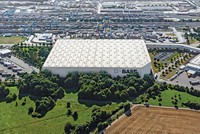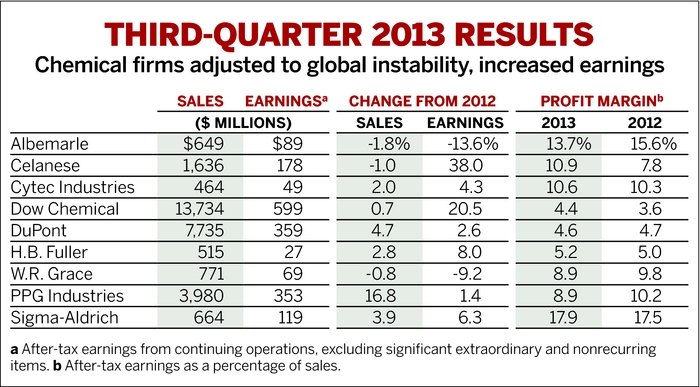Advertisement
Grab your lab coat. Let's get started
Welcome!
Welcome!
Create an account below to get 6 C&EN articles per month, receive newsletters and more - all free.
It seems this is your first time logging in online. Please enter the following information to continue.
As an ACS member you automatically get access to this site. All we need is few more details to create your reading experience.
Not you? Sign in with a different account.
Not you? Sign in with a different account.
ERROR 1
ERROR 1
ERROR 2
ERROR 2
ERROR 2
ERROR 2
ERROR 2
Password and Confirm password must match.
If you have an ACS member number, please enter it here so we can link this account to your membership. (optional)
ERROR 2
ACS values your privacy. By submitting your information, you are gaining access to C&EN and subscribing to our weekly newsletter. We use the information you provide to make your reading experience better, and we will never sell your data to third party members.
Business
Chemical Firms Hit By Economy
Agriculture businesses help some companies, but demand declines elsewhere and crimps earnings
by Melody Voith
November 17, 2008
| A version of this story appeared in
Volume 86, Issue 46
THE INDUSTRIAL CHEMICAL and agricultural chemical businesses accelerated their moves in opposite directions in the third quarter. Combined, 24 companies tracked by C&EN posted an impressive 20.4% increase in earnings over last year's third quarter. But take out fertilizer makers Terra Industries and Mosaic, and average earnings plummeted 8.7%.
Almost half of the companies on the C&EN list saw earnings decline, compared with five firms that declined in the third quarter of 2007. Sixteen of the 24 firms saw their profit margins erode. The weak results came despite the fact that only one company, Chemtura, saw sales decline in the third quarter.
September's Hurricanes Gustav and Ike took a lot of the blame for poor third-quarter results, although most companies accounted for the hurricanes with one-time charges that C&EN does not include in order to reflect ongoing business performance. Of the companies on the C&EN list, Albemarle, Celanese, Cytec Industries, Dow Chemical, DuPont, Huntsman Corp., Lubrizol, Nalco, PPG Industries, and Rohm and Haas all included impacts from the hurricanes in their earnings reports.
DuPont took an after-tax hurricane-related charge of $146 million on its quarterly earnings. Even without the charge, the company saw earnings decline by 7.1% on a 9.3% increase in sales compared with last year. In its report to investors, the company attributed the diminished result to higher costs for raw materials, energy, and freight and to lower sales volumes.
According to DuPont Chief Executive Officer Charles O. Holliday Jr., the company had several areas of strength during the quarter. He told analysts in a conference call that "key elements of our business strategies are working, and we will continue to drive them hard. Those include positioning in growth markets such as agriculture, electronics, and energy conservation."
Strong demand for DuPont's agriculture and nutrition products drove up sales for that business by 22% to $1.3 billion. Dow saw a similar 24% sales increase in its agricultural sciences business. For both companies, the lion's share of increased sales was due to higher prices rather than larger volumes.
HIGH DEMAND for agriculture commodities had an even more potent impact on the financial results of pure-play fertilizer companies. Mosaic's sales increased 115.8% from third-quarter 2007, and earnings shot up by almost a factor of three because of much higher selling prices. Offshore sales combined with the weak dollar to bring in $86.7 million from foreign currency exchange benefits alone.
Industry watchers expect the growth for fertilizer makers will continue. In a report to clients, Citigroup stock analyst Brian Yu wrote, "Our positive industry thesis is driven by expectations for global grain inventories to remain low through 2009, which we believe provides a good leading indicator of strong fertilizer demand and grain prices."
Without the fertilizer makers, the chemical companies tracked by C&EN saw their sales increase by 14.8% in the third quarter. But there was little evidence of real demand growth for nonagricultural products in their reports. In fact, many chemical sectors that are part of the consumer goods supply chain are experiencing noticeably weaker demand.
For example, Ferro's 10.5% increase in sales revenue was primarily due to price increases and changes in foreign exchange. In its specialty plastics segment, the company reported that sales decreased 5% "as a result of lower demand from customers in the automotive, appliance, and housing markets."
According to Ryan Sweet, senior economist at analysis firm Moody's Economy.com, chemical company results show that the impact of the global credit crisis is leaking into the rest of the economy. "There has been a considerable amount of demand destruction," Sweet says. "Banks are starving consumers and businesses of liquidity, and they are putting off purchases of big-ticket items."
The theme of flat or declining production volumes was repeated many times in company reports for the third quarter. Cytec reported that its quarterly earnings were exactly the same as last year's and that sales volumes in its coatings business decreased 5%. According to Cytec CEO David Lilley, the company "continued to experience weak demand in North America, and we began to see a further than expected slowdown in both North America and Europe toward the end of the quarter."
Results from Air Products & Chemicals and Chemtura suggest that declines in consumer goods demand have begun to drag down earnings. Operating income in Air Products' electronics and performance materials segment declined because of what the firm called a global slowdown in both semiconductor and liquid-crystal display manufacturing. At Chemtura, sales of pool treatment chemicals were down "due to cold weather and an uncertain economy that is constraining consumer spending."
Moody's Sweet warns that weak demand in the third quarter is likely only the tip of the iceberg. "As more developed countries fall into recession, you will see more pullback in demand. Consumer confidence is in the dumps, and everyone is concerned about jobs and incomes," he says.
So far, the impact of soft demand for chemicals has been mitigated by higher prices, which chemical companies instituted to make up for increased raw material and energy costs. But since the third quarter closed, the poor economic outlook has lowered energy demand, and the price of oil has come down markedly. Analysts say it is unclear how long companies will be able to hold on to their pricing power.
"Pricing is still robust, except for construction and auto markets, which have turned negative," observes Dmitry Silversteyn, a chemical stock analyst at Longbow Research. "The question becomes, 'What happens next year when raw material costs soften and volumes are moderate or in decline?' With nothing to underpin the need to raise prices, will companies maintain pricing discipline of the last two or three years?" he asks.
Silversteyn suggests that raw material cost decreases may impel some companies to drop chemical prices in 2009 to gain market share and keep their plants running. On the other hand, some firms may benefit from the long-awaited relief in raw material prices. "Lower costs would especially help those companies that are behind in price increases. If they can hold on to their prices, they would see margin expansions," Silversteyn says.
ONE COMPANY that is likely to benefit from a drop in raw material costs is Cabot. Its core carbon black and metals businesses suffered from both high raw material costs and declining volumes. But Cabot's biggest dilemma was being locked into $36 million in unfavorable contracts that prevented it from raising prices. Overall, Cabot's quarterly earnings decreased 58.6% compared with last year.
Chemical company pricing power will erode if makers of consumer goods project low consumer demand and start trimming purchases, Sweet says. "The first thing that manufacturers do is adjust their inventories. They don't want an overhang of inventories during a recession and will try to line up with underlying demand. We're already seeing a destocking of inventories."
According to Sweet, two important economic indexes reveal a drop in U.S. consumer demand and a corresponding decline in manufacturing activity. The third-quarter gross domestic product showed that the economy contracted 0.3%. More important, Sweet says, was the supporting data that showed spending fell 14.1% on durables. Consumers cut back spending on nondurables by 6.4%, compared with a 3.9% gain in the previous quarter.
Meanwhile, the Chicago Purchasing Managers' Index, a measurement of manufacturing activity, fell a larger than expected 18.9 points to 37.8 in October, the lowest since the 2001 recession. Sweet described the details of the report as "horrible" and says they "suggest manufacturing will contract through the rest of this year and into the next."
If the recession becomes deep or prolonged, manufacturing facilities may go idle, Sweet cautions. "Purchasing won't pick up until the economy begins to stabilize and the pace of layoffs moderates," he says. "But we forecast that unemployment will increase throughout 2009, peaking near 8%, compared with a peak of 6.5% in the 2000 recession."







Join the conversation
Contact the reporter
Submit a Letter to the Editor for publication
Engage with us on Twitter